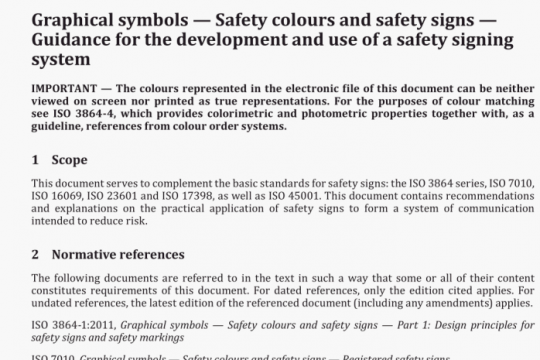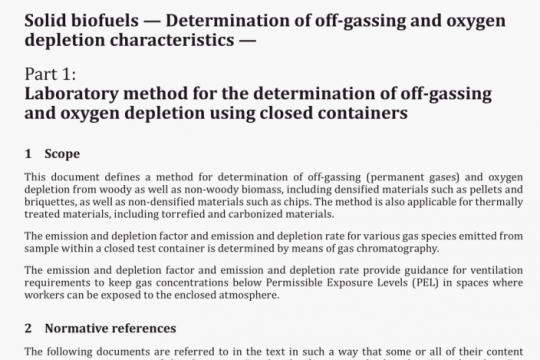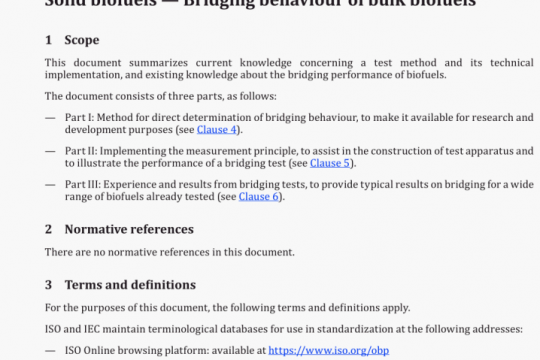ISO 3376 pdf free download
ISO 3376-2020 pdf free download.Leather – Physical and mechanical tests – Determination of tensile strength and percentage elongation.
6.3 If the test pieces are removed from standard atmosphere for cutting and not tested within
30 minutes, then the test pieces shall be returned straight away to the standard atmosphere for
conditioning in accordance with Iso 2419.
7 Procedure
7.1 Determination of dimensions
7.1.1 Using vernier callipers (55), measure the width of each test piece to the nearest 0,1 mm at three positions on the grain side and three on the flesh side. In each group of three measurements, make one at the mid-point E (as shown in Figurel) and the other two at positions approximately midway between the mid-point E and the lines AB and CD. Take the arithmetic mean of the six measurements as the width of the test piece, w. For soft (flexible) leather, the width b (in Figure 1) shall be taken as the width of the press knife.
7.1.2 Measure the thickness of each test piece in accordance with ISO 2589. Make the measurements at three positions, namely the mid-point E and at positions approximately midway between the midpoint E and the lines AB and CD. Take the arithmetic mean of the three measurements as the thickness of the test piece, t.
7.2 Determination of tensile strength
7.2.1 If L3 and/or L4 are also required to be carried out, then the same test piece may be used to complete Z2. 2,3 and/or 7,4 in a single test, providing the preload and initial length measurement described in Zjj. is carried out at Z2J..
7.2.2 Set the jaws of the tensile testing apparatus (&1) (50 ± 1) mm apart if using the standard test piece or (100 ± 1) mm apart if using the large test piece. Clamp the test piece in the jaws so that the edges of the jaws lie along the lines AB and CD. When the test piece is clamped, ensure its grain surface lies in one plane. The length axis shall be parallel to the traction direction.
7.2.3 Run the machine until the test piece breaks and record the highest force exerted as maximum force, Fmax.
7.2.4 For tensile strength determination, the recorded Fmax value shall be used for calculation.
NOTE Variable results can occur if using the force at the test piece’s break, Fbreak, instead of Fmax, depending on the type of leather.
7.3 Determination of the percentage elongation caused by a specified load
7.3.1 Clamp the test piece between the jaws of the apparatus, as described in 722. For measurement of elongation a slight tension shall be applied by means of a pre-load. This may be achieved by:
a) manually applying a low load below the clamping position CD as the lower jaw is closed, or
b) instrumentally using the tensile testing machine (5i) to apply a pre-load.
An instrumental pre-load value may be chosen according to the maximum force, Fniax of the leather to be tested or as otherwise specified by the client. Examples of instrumental pre-load values are:
— for Fmax < 100 N, a pre-load of 0,5 N;
— for 100 N < Fmax < 300 N, a pre-load of 2,0 N;
— for Fmax> 300 N, a pre-load of 5 N;
and in each case there should be no significant elongation.
If the leather’s maximum force, Fmax is unknown, a pre-test as described in 72 using an additional test piece for each test direction is required; for these additional test pieces and only for this pre-test determination, it is not necessary to carry out the determination of dimensions described in 7.1.
Measure the distance between the jaws to at least the nearest 0,5 mm and record this distance, L0, as the initial length of the test piece for the purpose of the test.
7.3.2 Start the test. Unless the apparatus automatically draws a force/elongation curve with the necessary accuracy (see 51. b). follow the distance between the pair of jaws or the sensors as the force increases.
7.3.3 Note the distance, in millimetres, between the pair of jaws or sensors at the instant when the force first reaches the specified value. This distance represents the length of the test piece at this force, L1. Do not stop the apparatus if results from the procedures described in 22 or 7,4 are also required.
7.4 Determination of the percentage elongation at maximum force
7.4.1 Carry out the steps given in 7.I1.
7.4.2 Run the tensile test machine until the test piece breaks.
7.4.3 Record the distance, L2, between the jaws or sensors at maximum force Fmar
NOTE Variable results can occur if using the elongation at the test piece’s break, Ebreflk. instead of Emax, depending on the type of leather.
7.5 Slippage
If any visible sign of slippage of the test piece is seen in either jaw when tested according to 72. 7.3 or 7i reject the result and repeat the determination with a new test piece cut using the large press knife (5A).
8 Expression of results
8.1 Tensile strength
The tensile strength, T, in MPa (or newtons per square millimetre, if required) shall be calculated using Formula (1).ISO 3376 pdf download.




